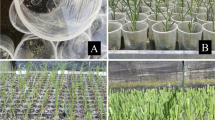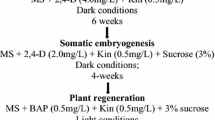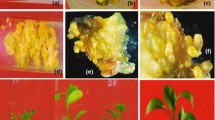Abstract
The current study assessed the embryogenic potential of different Brazilian Saccharum spp. hybrid (sugarcane) varieties, using explants from previously established in vitro plants, and determined the morphogenic capacity of calluses to regenerate plants during consecutive subcultures. After examining various explant lengths (1 to 15 mm) for callus initiation, an optimal length of 12 mm was determined, and 14 sugarcane varieties were studied. Callus induction occurred on Murashige and Skoog medium with 3.0 mg L−1 2,4-dichlorophenoxyacetic acid, in the dark. After 40 d, calluses were divided according to their predominant type: the mucilaginous part remained in the dark on fresh induction medium, whereas the compact nodular callus fraction was transferred to a regeneration medium containing 1.86 mg L−1 1-naphthaleneacetic acid and 0.09 mg L−1 6-benzylaminopurine and was cultivated in light. This callus selection based on morphological type took place over three consecutive subcultures, spanning 22 wk. The embryogenic process was asynchronous and the formation of the first plants was registered at 6 wk of cultivation. The embryogenic callus regeneration rate was kept at over 60% until the third subculture in 13 of the 14 varieties examined. However, delayed regeneration was observed, likely due to the aging of calluses. The protocol reported here utilized the embryogenic potential of sugarcane varieties in combination with efficient and quick regeneration and should thus provide an attractive alternative source material for the production of transgenics and/or large-scale clonal multiplication of sugarcane.




Similar content being viewed by others
References
Ahloowalia BS, Maretzki A (1983) Plant regeneration via somatic embryogenesis in sugarcane. Plant Cell Rep 2:21–25
Alcantara GB, Dibax R, Oliveira RA, Bespalhok Filho JC, Daros E (2014) Plant regeneration and histological study of the somatic embryogenesis of sugarcane (Saccharum spp.) cultivars RB855156 and RB72454. Acta Sci Agron 36:63–72
Almeida M, Almeida CV, Graner EM, Brondani GE, Abreu-Tarazi MF (2012) Pre-procambial cells are niches for pluripotent and totipotent stem-like cells for organogenesis and somatic embryogenesis in the peach palm: a histological study. Plant Cell Rep 31:1495–1515
Basnayake SWV, Moyle R, Birch RG (2011) Embryogenic callus proliferation and regeneration conditions for genetic transformation of diverse sugarcane cultivars. Plant Cell Rep 30:439–448
Brasil (2016) Ministério da Agricultura. Cana-de-açúcar. http://www.agricultura.gov.br/vegetal/culturas/cana-de-acucar. Accessed 24 Aug 2016
Brisibe EA, Nishioka D, Miyake H, Taniguchi T, Maeda E (1993) Developmental electron microscopy and histochemistry of somatic embryo differentiation in sugarcane. Plant Sci 89:85–92
Brisibe EA, Miyake H, Taniguchi T, Maeda E (1994) Regulation of somatic embryogenesis in long-term callus cultures of sugarcane (Saccharum officinarum L.). New Phytol 126:301–307
Chen WH, Davey MR, Power JB, Cocking EC (1988) Control and maintenance of plant regeneration in sugarcane callus culture. J Exp Bot 39:251–261
Conab, Companhia Nacional de Abastecimento (2018) Acompanhamento da safra brasileira: cana-de-açúcar, v.4, Safra 2017/18. Brasília, 73 p
Dibax R, Alcantara GB, Machado MP, Bespalhok Filho JC, Oliveira RA (2011) Plant regeneration of sugarcane cv. RB931003 and RB98710 from somatic embryos and acclimatization. J Biotechnol Biodivers 2:32–37
Dibax R, Alcantara GB, Machado MP, Bespalhok Filho JC, Oliveira RA (2013) Protocol optimization and histological analysis of in vitro plant regeneration of ‘RB92579’ and ‘RB93509’ sugarcane cultivars. Ciência Rural 43:49–54
Falco MC, Mendes BMJ, Tulmann Neto A, Appezzato da Glória B (1996) Histological characterization of in vitro regeneration of Saccharum sp. Rev Bras Fisiol Veg 8:93–97
Ferreira DF (2011) Sisvar: a computer statistical analysis system. Ciencia e Agrotecnologia 35:1039–1042
Garcia R, Cidade D, Castellar A, Lips A, Magioli C, Callado C, Mansur E (2007) In vitro morphogenesis patterns from shoot apices of sugarcane are determined by light and type of growth regulator. Plant Cell Tissue Organ Cult 90:181–190
Gosal SS, Thind KS, Dhaliwal HS (1998) Micropropagation of sugarcane-an efficient protocol for commercial plant production. Crop Improv 25:167–171
Ho WJ, Vasil IK (1983) Somatic embryogenesis in sugarcane (Saccharum officinarum L.) I. The morphology and physiology of callus formation and the ontogeny of somatic embryos. Protoplasma 118:169–180
Hsie BS, Brito JZ, Vila Nova MX, Borges-Paluch LR, Silva MV, Donato VMST (2015) Determining the genetic stability of micropropagated sugarcane using inter-simple sequence repeat markers. Genet Mol Res 14:17651–17659
Johansen DA (1940) Plant microtechnique. McGraw-Hill Book, New York
Joyce P, Kuwahata M, Turner N, Lakshmanan P (2010) Selection system and co-cultivation medium are important determinants of Agrobacterium-mediated transformation of sugarcane. Plant Cell Rep 29:173–183
Kaur R, Kapoor M (2016) Plant regeneration through somatic embryogenesis in sugarcane. Sugar Tech 18:93–99
Krikorian AD, Berquam DL (1969) Plant cell and tissue cultures: the role of Haberlandt. Bot Rev 35:59–67
Landell MGA, Campana MP, Figueiredo P, Xavier MA, Anjos IA, Dinardo-Miranda LL, Scarpari MS, Garcia JC, Bidóia MAP, Silva DN, Mendonça JR, Kanthack RAD, Campos MF, Brancalião SR, Petri RH, Miguel PEM (2012) Sistema de multiplicação de cana-de-açúcar com uso de mudas pré-brotadas (MPB), oriundas de gemas individualizadas. Ribeirão Preto: Instituto Agronômico de Campinas, 17 p. (IAC. Documentos, 109)
Lee TSG (1987) Micropropagation of sugarcane (Saccharum spp.). Plant Cell Tissue Organ Cult 10:47–55
Manickavasagam M, Ganapathi A, Anbazhagan VR, Sudhakar B, Selvaraj N, Vasudevan A, Kasthurirengan S (2004) Agrobacterium-mediated genetic transformation and development of herbicide-resistant sugarcane (Saccharum species hybrids) using axillary buds. Plant Cell Rep 23:134–143
Martínez-Estrada E, Caamal-Velázquez JH, Salinas-Ruíz J, Bello-Bello JJ (2017) Assessment of somaclonal variation during sugarcane micropropagation in temporary immersion bioreactors by intersimple sequence repeat (ISSR) markers. In Vitro Cell Dev Biol - Plant 53:553–560
Moutia M, Dookun A (1999) Evaluation of surface sterilization and hot water treatments on bacterial contaminants in bud culture of sugarcane. Exp Agric 35:265–274
Murashige T, Skoog F (1962) A revised medium for rapid growth and bioassays with tobacco tissue cultures. Physiol Plant 15:473–497
Nogueira GF, Pasqual M, Scherwinski-Pereira JE (2013) Survival of sugarcane shoot tips after cryopreservation by droplet-vitrification. Pesq Agrop Brasileira 48:1524–1527
Nogueira GF, Pio LAS, Pasqual M, Amaral A, Scherwinski-Pereira JE (2015) An approach on the in vitro maintenance of sugarcane with views for conservation and monitoring of plant nuclear DNA contents via flow cytometry. In Vitro Cell Dev Biol - Plant 51:220–230
O’Brien TP, Feder N, McCully ME (1964) Polychromatic staining of plant cell walls by toluidine blue. Protoplasma 59:368–373
Pola S, Mani S, Ramana T (2009) Long-term maintenance of callus cultures from immature embryo of Sorghum bicolor. World J Agric Sci 5:415–421
Ramage CM, Williams RR (2004) Cytokinin-induced abnormal shoot organogenesis is associated with elevated Knotted1-type homeobox gene expression in tobacco. Plant Cell Rep 22:919–924
Sané D, Aberlenc-Bertossi F, Gassama-Dia YK, Sagna M, Trouslot MF, Duval Y, Borgel A (2006) Histocytological analysis of callogenesis and somatic embryogenesis from cell suspensions of date palm (Phoenix dactylifera). AoB Plant 98:301–308
Scherwinski-Pereira JE, Guedes RS, Silva RA, Fermino JRPCP, Luis ZG, Freitas EO (2012) Somatic embryogenesis and plant regeneration in açaí palm (Euterpe oleracea). Plant Cell Tissue Organ Cult 109:501–508
Seema G, Pande HP, Lal J, Madan VK (2001) Plantlet regeneration of sugarcane varieties and transient gus expression in calli by electroporation. Sugar Tech 3:27–33
Sengar RS, Sengar K, Garg SK (2011) Biotechnological approaches for high sugarcane yield. Plant Sci Feed 1:101–111
Simões Neto DE (2009) Variedades de cana–de–açúcar no Estado de Pernambuco contribuição do melhoramento Clássico da Ridesa–Ufrpe. Anais da Academia Pernambucana Ciên Agron 5–6:125–146
Sindaçucar (2018) Sindicato da Indústria do Açúcar no Estado de Pernambuco. http://www.sindacucar-al.com.br/variedades/. Accessed 20 Dec 2018
Singh G, Sandhu SK, Meeta M, Singh K, Gill R, Gosal SS (2008) In vitro induction and characterization of somaclonal variation for red rot and other agronomic traits in sugarcane. Euphytica 160:35–47
Singh RK, Kumar P, Tiwari NN, Rastogi J, Singh SP (2013) Current status of sugarcane transgenic: an overview. Adv Genet Eng 2:2–7
Sobhakumari VP (2012) Assessment of somaclonal variation in sugarcane. Afr J Biotechn 11:15303–15309
Taparia Y, Gallo M, Altpeter F (2012) Comparison of direct and indirect embryogenesis protocols, biolistic gene transfer and selection parameters for efficient genetic transformation of sugarcane. Plant Cell Tissue Organ Cult 111:131–141
Tiwari AK, Bharti YP, Tripathi S, Mishra N, Lal M, Rao GP, Sharma PK, Sharma ML (2010) Biotechnological approaches to improve sugarcane crop with special reference to disease resistance. Acta Phytopath Entomol Hung 45:235–249
von Arnold S, Sabala I, Bozhkov P, Dyachok J, Filonova L (2002) Developmental pathways of somatic embryogenesis. Plant Cell Tissue Organ Cult 69:233–249
Acknowledgments
We would like to thank Dr. Adriane Amaral (Embrapa Tabuleiros Costeiros, Aracaju, Brazil) for providing the biological material for the experiments.
Funding
Current research was partially funded by the Conselho Nacional de Desenvolvimento Científico e Tecnológico (CNPq, Grant 305121/2015-4), by Financiadora de Estudos e Projetos (Finep, Grant 01.08.0597.01), and by Coordenação de Aperfeiçoamento de Pessoal de Nível Superior (Capes/Embrapa 001-2011/Grant 39).
Author information
Authors and Affiliations
Contributions
GFN performed experiments, analyzed and interpreted data, and wrote the manuscript. ZGL helped with the morpho-anatomical and histochemical analyses. MP analyzed data and wrote the manuscript. JESP assisted in the selection and collection of sugarcane material in the field, designed experiments, analyzed and interpreted data, and wrote the manuscript. All authors agreed on the final version for publication.
Corresponding author
Ethics declarations
Conflict of interest
The authors declare that they have no conflicts of interest.
Additional information
Editor: Prakash Lakshmanan
Rights and permissions
About this article
Cite this article
Nogueira, G.F., Luis, Z.G., Pasqual, M. et al. High-efficiency somatic embryogenesis of a broad range of Brazilian Saccharum spp. hybrids (sugarcane) varieties using explants from previously established in vitro plants. In Vitro Cell.Dev.Biol.-Plant 55, 26–35 (2019). https://doi.org/10.1007/s11627-018-09954-2
Received:
Accepted:
Published:
Issue Date:
DOI: https://doi.org/10.1007/s11627-018-09954-2




